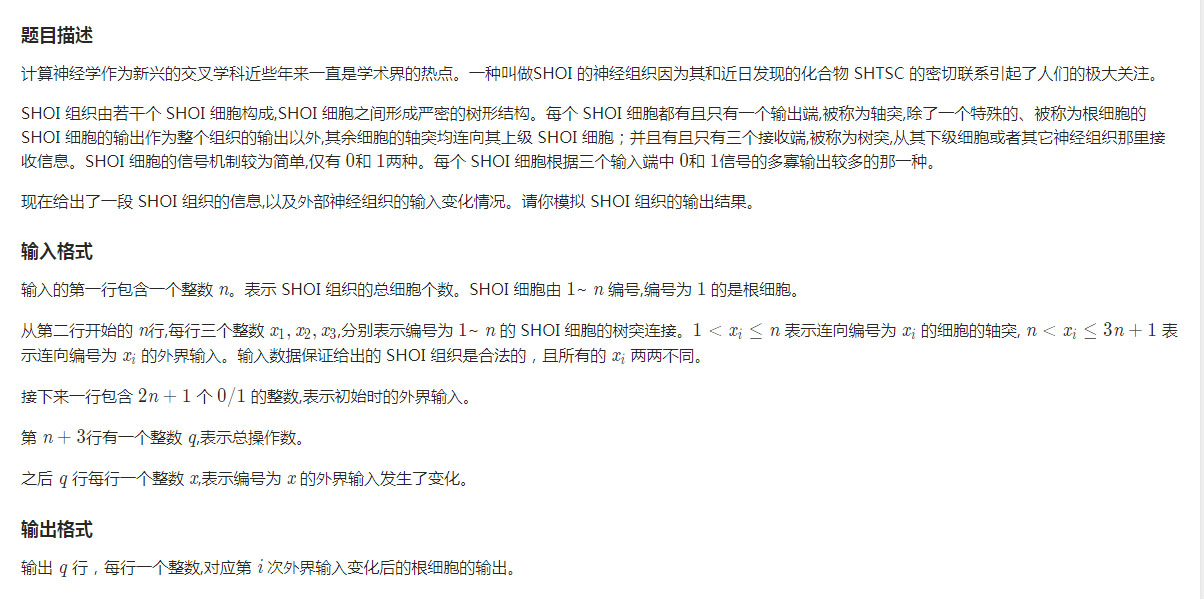第一次写黑题,好紧张(bushi)
这道题可以说是一道LCT的练手题,首先对于题目中给出的树,如果我们改变一个叶子节点的值,那么影响范围是它的父节点,如果父节点改变了,那么爷爷节点也可能会改变,那么我们猜想,是否存在一段连锁的改变呢?
显然,如果用0/1/2/3表示一个节点的状态,即儿子含有数字1的个数,那么对于由浅到深的一段1/0/1/1/0中,最深的一个0节点变为了1,那么序列就会变为:1/1/2/2/1,至多影响到浅层的那个0节点。
如果考虑到由1变为0,其实是一个道理,(这里连锁的是2)因此,我们考虑维护一段自底向上的区间,满足含有一段连续的1/2,直到出现一个不为1/2的点,然后修改区间,再单独修改那个点,就完成了维护。
具体的说,我们先打通题目给的点x,打通路径,再查找最深的那个不为1/2的节点,进行修改,其中有些小技巧:
1.叶子节点乘以2,树枝等于叶子节点之和除以2,这样会方便些。
2.向上更新的步骤:因为splay维护的是深度,所以从右->自己->左的顺序最好,分别判断一下。
3.向下传递的步骤:实质就是将区间上的每个1变为2,2变为1,将值异或3即可,同时要交换x的维护数组num1,num2(因为这个时候一段1的序列会全部变为2,等于是同时在维护一段2序列了)
4.注意卡常,把inline啊register int啊还有什么快读都开了,时间从4.2s直降到200ms。
5.我被内存坑惨了,开正常大小会出各种WA,RE,MLE啥的,就开大了几倍,全变TLE了,以后开数组大小要根据题目给的要求尽量开大点。
1 #include<bits/stdc++.h> 2 using namespace std; 3 #define rs c[x][1] 4 #define ls c[x][0] 5 const int N=2e6+5; 6 int n; 7 int f[N],cnt,sum[N],q,tot,head[N],aa,bb,cc,ans; 8 int c[N][2],st[N],num2[N],num1[N],tag[N]; 9 inline int read() 10 { 11 int ans = 0,op = 1;char ch = getchar(); 12 while(ch < '0' || ch > '9') {if(ch == '-') op = -1;ch = getchar();} 13 while(ch >='0' && ch <= '9') ans = ans * 10 + ch - '0',ch = getchar(); 14 return ans * op; 15 } 16 struct edge{ 17 int next,to; 18 }e[N<<1]; 19 void addedge(int from,int to){ 20 e[++cnt].to=to; 21 e[cnt].next=head[from]; 22 head[from]=cnt; 23 } 24 void dfs(int u){ 25 for(int i=head[u];i;i=e[i].next){ 26 dfs(e[i].to); 27 sum[u]+=(sum[e[i].to]>>1); 28 } 29 } 30 int nroot(int x){ 31 return c[f[x]][0]==x||c[f[x]][1]==x; 32 } 33 void pushup(int x){ 34 num1[x]=num1[rs]; 35 if(!num1[x]&&sum[x]!=1) num1[x]=x; 36 if(!num1[x]) num1[x]=num1[ls]; 37 num2[x]=num2[rs]; 38 if(!num2[x]&&sum[x]!=2) num2[x]=x; 39 if(!num2[x]) num2[x]=num2[ls]; 40 } 41 void pusm(int x,int d){ 42 sum[x]^=3; 43 swap(num1[x],num2[x]); 44 tag[x]+=d; 45 } 46 void pushdown(int x){ 47 if(nroot(x)) pushdown(f[x]); 48 if(tag[x]){ 49 pusm(ls,tag[x]); 50 pusm(rs,tag[x]); 51 tag[x]=0; 52 } 53 } 54 void rotate(int x){ 55 int y=f[x],z=f[y],k=c[y][1]==x,w=c[x][k^1]; 56 if(nroot(y)) c[z][c[z][1]==y]=x; 57 c[x][k^1]=y; 58 c[y][k]=w; 59 if(w) f[w]=y; 60 f[y]=x; 61 f[x]=z; 62 pushup(y); 63 64 } 65 void splay(int x){ 66 pushdown(x); 67 int y=x,z=0; 68 st[++z]=y; 69 while(nroot(y)) st[++z]=y=f[y]; 70 while(z) pushdown(st[z--]); 71 while(nroot(x)){ 72 y=f[x],z=f[y]; 73 if(nroot(y)) rotate((c[y][0]==x)^(c[z][0]==y)?x:y); 74 rotate(x); 75 } 76 pushup(x); 77 } 78 void access(int x){ 79 for(int g=0;x;x=f[g=x]){ 80 splay(x); 81 rs=g; 82 pushup(x); 83 } 84 } 85 int main(){ 86 // freopen("neuron.in","r",stdin); 87 // freopen("neuron.out","w",stdout); 88 n=read(); 89 int i; 90 for(i=1;i<=n;i++){ 91 aa=read(),bb=read(),cc=read(); 92 f[aa]=f[bb]=f[cc]=i; 93 addedge(i,aa); 94 addedge(i,bb); 95 addedge(i,cc); 96 } 97 for(;i<=3*n+1;i++){ 98 aa=read(); 99 sum[i]=(aa<<1); 100 } 101 dfs(1); 102 q=read(); 103 ans=sum[1]>>1; 104 for(i=1;i<=q;i++){ 105 aa=read(); 106 sum[aa]^=2;//单点修改 107 int k=sum[aa]-1; 108 aa=f[aa]; 109 access(aa); 110 splay(aa);//将区间的端点旋转到根 111 int p=(~k)?num1[aa]:num2[aa];//找到最深的非1或2点 112 if(!p) pusm(aa,k),pushup(aa),ans^=1;//如果这个点不存在,说明就是原树根了 113 else{ 114 splay(p);//这个时候aa点已经在p的右子树了 115 pusm(c[p][1],k); 116 pushup(c[p][1]); 117 sum[p]+=k; 118 pushup(p); 119 } 120 printf("%d\n",ans); 121 } 122 return 0; 123 }
